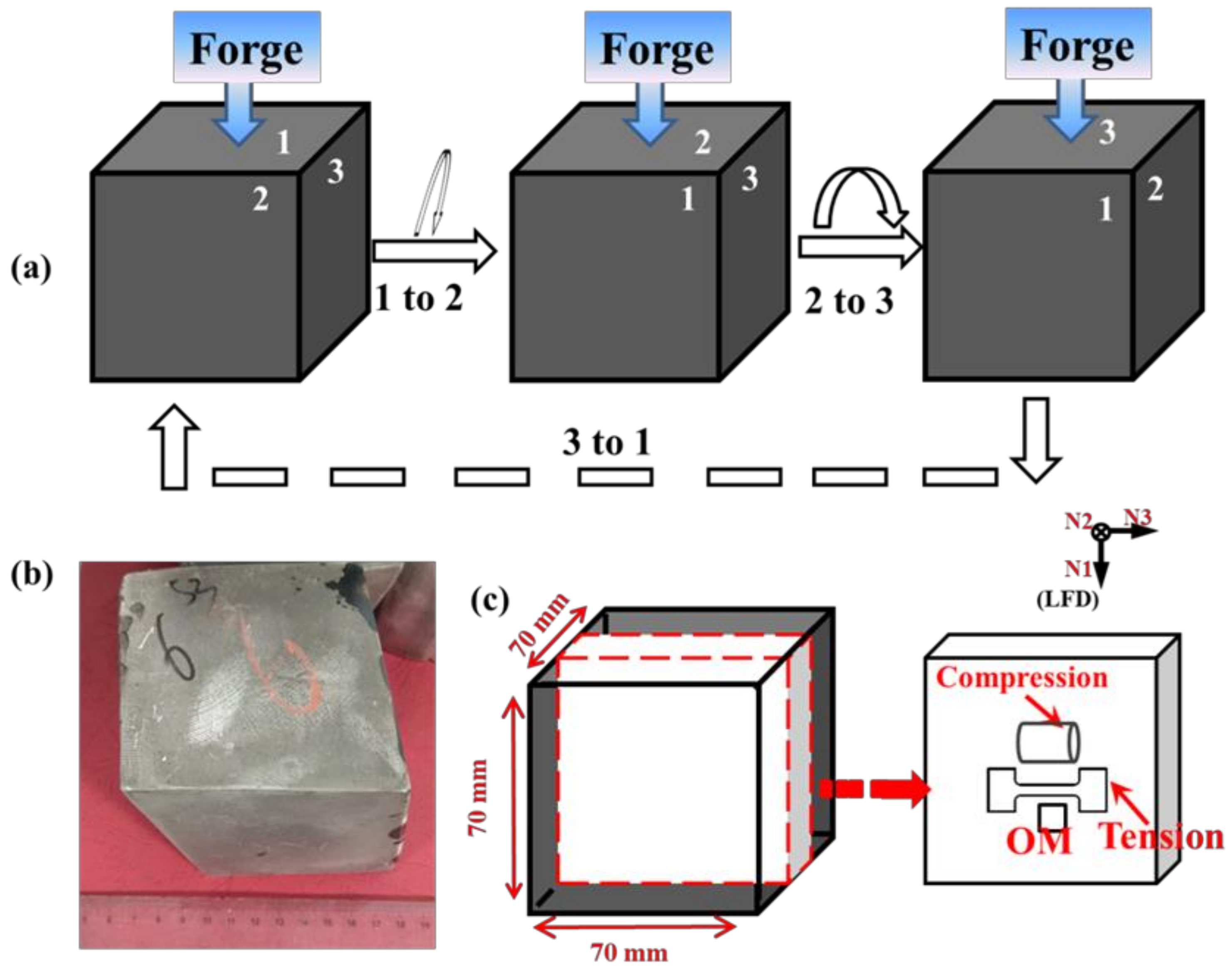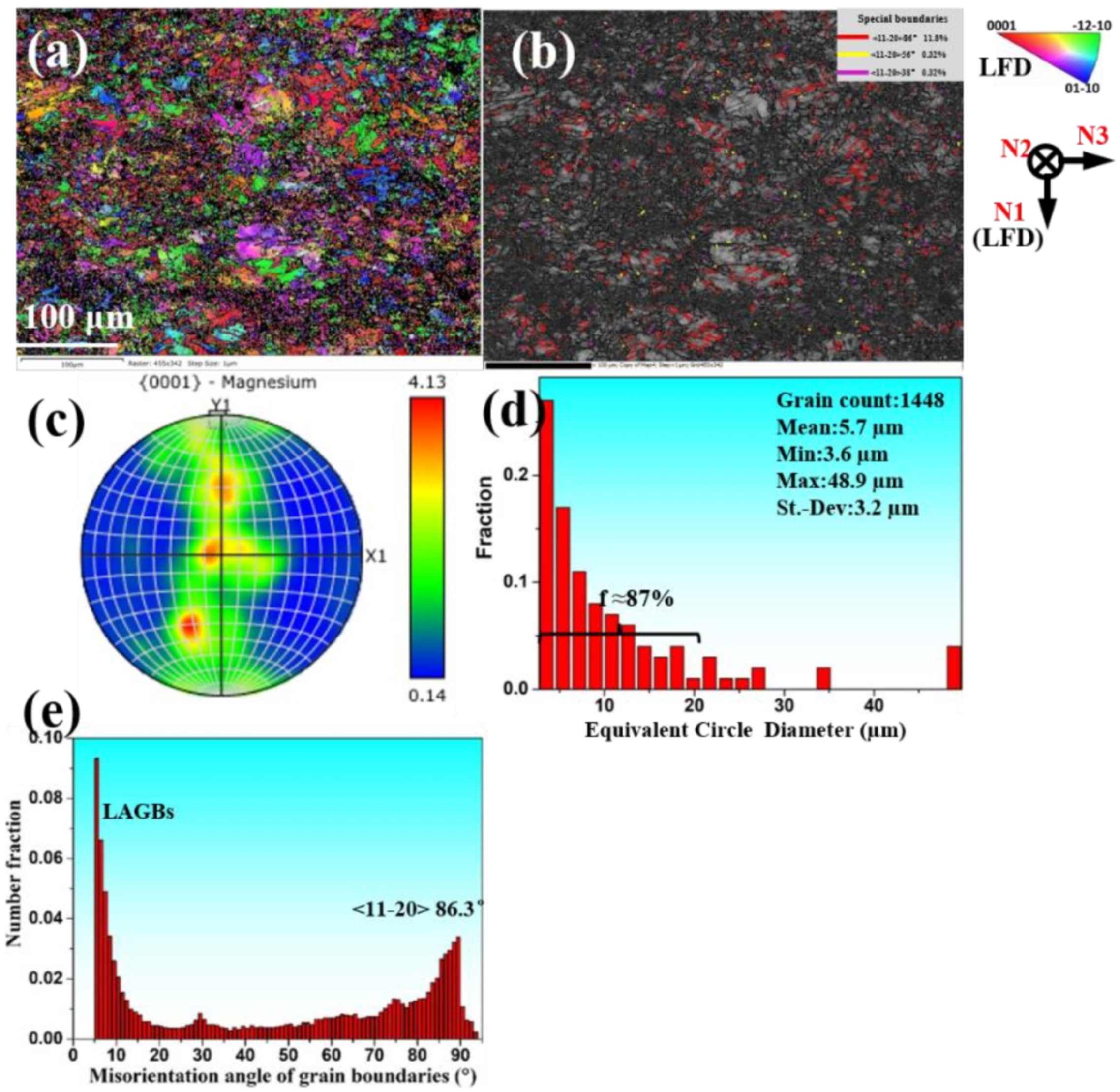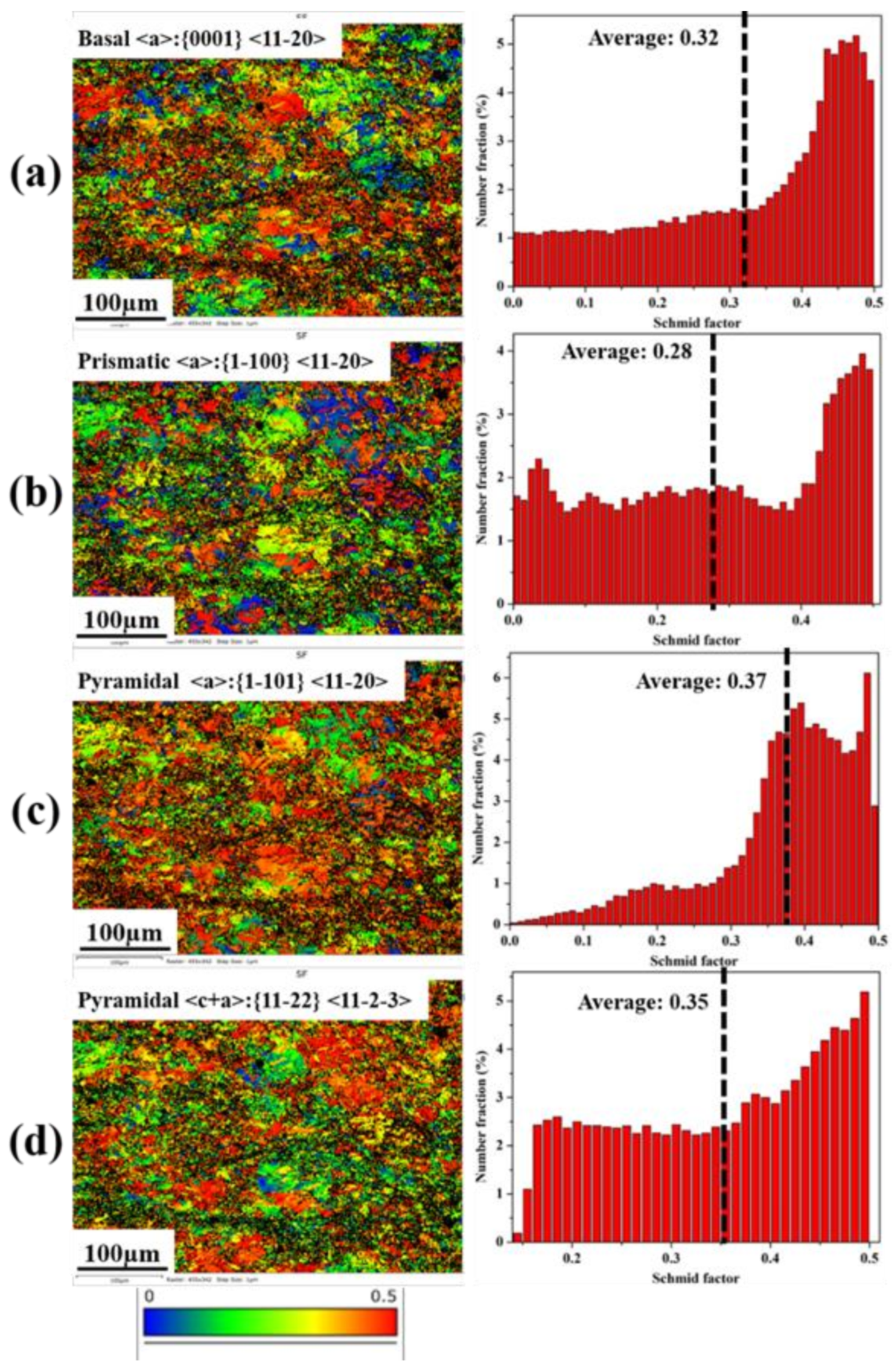Achieving High-Strength and Toughness in a Mg-Gd-Y Alloy Using Multidirectional Impact Forging
Abstract
:1. Introduction
2. Materials and Methods
3. Results
3.1. Initial State of the Alloy
3.2. Microstructure and Mechanical Property of MDIF100+100 Sample
4. Discussion
4.1. Contribution of {10–12} Twins to Microstructure Refinement
4.2. High Strength and Toughness GW52 Alloy
5. Conclusions
- (1)
- Multidirectional impact forging has been proved to be an efficient methodology in grain refinement and property improvement of Mg-Gd-Y alloy. After the MDIF of 100+100 forging passes, the TYS of GW52 alloy increased from MPa to MPa and the ST also increased from 22. MJ/m3, to 49. MJ/m3. As a result, the MDIF realized 151 MPa increment (112%) for TYS and 22.0 MJ/m3 increment (117%) for ST simultaneously.
- (2)
- The MDIF100+100 sample of GW52 alloy has a relatively fine-grained microstructure ~5.7 µm, exhibiting a random texture. Furthermore, high TYS of MPa, EL of 11.%, and ST of 50. MJ/m3 were gained in the GW52 alloy developed by MDIF and aging treatment.
- (3)
- The forged GW52 alloy exhibits yield isotropy (the ratio of compression yield strength/tensile yield strength along the forging direction is ≈1.0). Compared with forged Mg-Al-Zn and Mg-Gd-Y based alloys, the forged GW52 alloy exhibited excellent strength–ductility balance resulting from the combined effect of fine-grained strengthening, twin strengthening, and its non-basal texture.
Supplementary Materials
Author Contributions
Funding
Institutional Review Board Statement
Informed Consent Statement
Data Availability Statement
Conflicts of Interest
References
- Zhang, K.; Zheng, J.-H.; Huang, Y.; Pruncu, C.; Jiang, J. Evolution of twinning and shear bands in magnesium alloys during rolling at room and cryogenic temperature. Mater. Des. 2020, 193, 108793. [Google Scholar] [CrossRef]
- Pan, H.; Kang, R.; Li, J.; Xie, H.; Zeng, Z.; Huang, Q.; Yang, C.; Ren, Y.; Qin, G. Mechanistic investigation of a low-alloy Mg–Ca-based extrusion alloy with high strength–ductility synergy. Acta Mater. 2020, 186, 278–290. [Google Scholar] [CrossRef]
- Springer, H.; Baron, C.; Szczepaniak, A.; Uhlenwinkel, V.; Raabe, D. Stiff, light, strong and ductile: Nano-structured High Modulus Steel. Sci. Rep. 2017, 7, 2757. [Google Scholar] [CrossRef] [Green Version]
- Zheng, R.; Du, J.-P.; Gao, S.; Somekawa, H.; Ogata, S.; Tsuji, N. Transition of dominant deformation mode in bulk polycrystalline pure Mg by ultra-grain refinement down to sub-micrometer. Acta Mater. 2020, 198, 35–46. [Google Scholar] [CrossRef]
- Zhang, B.; Wang, Y.; Geng, L.; Lu, C. Effects of calcium on texture and mechanical properties of hot-extruded Mg–Zn–Ca alloys. Mater. Sci. Eng. A 2012, 539, 56–60. [Google Scholar] [CrossRef]
- Hagihara, K.; Li, Z.; Yamasaki, M.; Kawamura, Y.; Nakano, T. Strengthening mechanisms acting in extruded Mg-based long-period stacking ordered (LPSO)-phase alloys. Acta Mater. 2019, 163, 226–239. [Google Scholar] [CrossRef]
- Chen, Z.H. Wrought Magnesiun; Chemical Industry Press: Beijing, China, 2005; p. 5. [Google Scholar]
- Jiang, M.; Xu, C.; Yan, H.; Fan, G.; Nakata, T.; Lao, C.; Chen, R.; Kamado, S.; Han, E.; Lu, B. Unveiling the formation of basal texture variations based on twinning and dynamic recrystallization in AZ31 magnesium alloy during extrusion. Acta Mater. 2018, 157, 53–71. [Google Scholar] [CrossRef]
- Huang, X.; Suzuki, K.; Chino, Y.; Mabuchi, M. Texture and stretch formability of AZ61 and AM60 magnesium alloy sheets pro-cessed by high-temperature rolling. J. Alloys Compd. 2015, 632, 94–102. [Google Scholar] [CrossRef]
- Zhou, X.; Zhang, J.; Chen, X.; Zhang, X.; Li, M. Fabrication of high-strength AZ80 alloys via multidirectional forging in air with no need of ageing treatment. J. Alloys Compd. 2019, 787, 551–559. [Google Scholar] [CrossRef] [Green Version]
- Xu, C.; Zheng, M.Y.; Wu, K.; Wang, E.D.; Fan, G.H.; Xu, S.W.; Kamado, S.; Liu, X.D.; Wang, G.J.; Lv, X.Y.; et al. Effect of final rolling reduction on the microstructure and mechanical properties of Mg–Gd–Y–Zn–Zr alloy sheets. Mater. Sci. Eng. A 2013, 559, 232–240. [Google Scholar] [CrossRef]
- Xie, Z.Y.; Tian, Y.; Li, Q.; Zhou, J.C.; Meng, Y. Effect of extrusion parameters on mi-crostructure and mechanical properties of Mg-7.5Gd-2.5Y-3.5Zn-0.9Ca-0.4Zr (wt%) alloy. Mater. Sci. Eng. A 2017, 685, 159–167. [Google Scholar]
- Lu, S.; Wu, D.; Chen, R.; Han, E.-H. The influence of temperature on twinning behavior of a Mg-Gd-Y alloy during hot compression. Mater. Sci. Eng. A 2018, 735, 173–181. [Google Scholar] [CrossRef]
- Lu, S.; Wu, D.; Chen, R.; Han, E.-H. The effect of twinning on dynamic recrystallization behavior of Mg-Gd-Y alloy during hot compression. J. Alloys Compd. 2019, 803, 277–290. [Google Scholar] [CrossRef]
- Zhu, S.; Yan, H.; Liao, X.; Moody, S.; Sha, G.; Wu, Y.; Ringer, S. Mechanisms for enhanced plasticity in magnesium alloys. Acta Mater. 2015, 82, 344–355. [Google Scholar] [CrossRef]
- Basu, I.; Al-Samman, T. Twin recrystallization mechanisms in magnesium-rare earth alloys. Acta Mater. 2015, 96, 111–132. [Google Scholar] [CrossRef]
- Barnett, M. Twinning and the ductility of magnesium alloys: Part II. “Contraction” twins. Mater. Sci. Eng. A 2007, 464, 8–16. [Google Scholar] [CrossRef]
- Chapuis, A.; Driver, J.H. Temperature dependency of slip and twinning in plane strain compressed magnesium single crystals. Acta Mater. 2011, 59, 1986–1994. [Google Scholar] [CrossRef]
- Lu, S.H.; Wu, D.; Chen, R.S.; Han, E.H. Microstructure and texture optimization by static recrystallization originating from {10–12} extension twins in a Mg-Gd-Y alloy. J. Mater. Sci. Technol. 2020, 59, 44–60. [Google Scholar] [CrossRef]
- Lu, S.H.; Wu, D.; Chen, R.S.; Han, E.H. Reasonable utilization of {10–12} twin for optimizing microstructure and improving mechanical property in a Mg-Gd-Y alloy. Mater. Des. 2020, 191, 108600–108621. [Google Scholar] [CrossRef]
- Yao, T.Z.; Xu, T.H.; Wang, D.H. Effect of yield ratio rising on use security of pipeline steels. Mater. Mech. Eng. 2012, 36, 62–68. [Google Scholar]
- Cai, W.; Morovat, M.A.; Engelhardt, M.D. True stress-strain curves for ASTM A992 steel for fracture simulation at elevated temperatures. J. Constr. Steel Res. 2017, 139, 272–279. [Google Scholar] [CrossRef]
- Xue, Z.Y.; Ren, Y.J.; Luo, W.B.; Ren, Y.; Xu, P.; Xu, C. Microstructure and mechanical properties of Mg–Gd–Y–Zn–Zr alloy sheets processed by combined processes of extrusion, hot rolling and ageing. Mater. Sci. Eng. A 2013, 559, 844–851. [Google Scholar] [CrossRef]
- Li, J.L.; Zhang, N.; Wang, X.X.; Wu, D.; Chen, R.S. Effect of Solution Treatment on the Microstructure and Mechanical Properties of Sand-Cast Mg–9Gd–4Y–0.5Zr Alloy. Acta Metall. Sin. Engl. Lett. 2017, 31, 189–198. [Google Scholar] [CrossRef]
- Hou, X.; Cao, Z.; Wang, L.; Xu, S.; Kamado, S.; Wang, L. Microstructure and mechanical properties of extruded Mg–8Gd–2Y–1Nd–0.3Zn–0.6Zr alloy. Mater. Sci. Eng. A 2011, 528, 7805–7810. [Google Scholar] [CrossRef]
- Nie, K.; Wang, X.; Deng, K.; Xu, F.; Wu, K.; Zheng, M. Microstructures and mechanical properties of AZ91 magnesium alloy processed by multidirectional forging under decreasing temperature conditions. J. Alloys Compd. 2014, 617, 979–987. [Google Scholar] [CrossRef]
- Nie, K.; Deng, K.; Wang, X.; Xu, F.; Wu, K.; Zheng, M. Multidirectional forging of AZ91 magnesium alloy and its effects on microstructures and mechanical properties. Mater. Sci. Eng. A 2015, 624, 157–168. [Google Scholar] [CrossRef]
- Guo, W.; Wang, Q.; Ye, B.; Zhou, H. Enhanced microstructure homogeneity and mechanical properties of AZ31–Si composite by cyclic closed-die forging. J. Alloys Compd. 2013, 552, 409–417. [Google Scholar] [CrossRef]
- Liu, Z.Y.; Jiang, X.Q.; Mu, F.; Li, H.D. Development progress of plastic working for AZ31 magnesium alloy. Light Met. 2008, 12, 59–63. [Google Scholar] [CrossRef]
- Chen, C.; Wang, R.; Du, X.H.; Wu, B.L. Improved Mechanical Properties of AZ31 Alloy Fabricated by Multi-Directional Forging. Key Eng. Mater. 2017, 727, 124–131. [Google Scholar] [CrossRef]
- Guo, Q.; Yan, H.; Chen, Z.; Zhang, H. Effect of mutiple forging process on microstructure and mechanical properties of Magnesium alloy AZ80. Acta Metall. Sin. 2006, 42, 739–744. [Google Scholar]
- Jiang, M.G.; Yan, H.; Chen, R.S. Microstructure, texture and mechanical properties in an as-cast AZ61 Mg alloy during multi-directional impact forging and subsequent heat treatment. Mater. Des. 2015, 87, 891–900. [Google Scholar] [CrossRef]
- Jiang, M.; Yan, H.; Chen, R. Enhanced mechanical properties due to grain refinement and texture modification in an AZ61 Mg alloy processed by small strain impact forging. Mater. Sci. Eng. A 2015, 621, 204–211. [Google Scholar] [CrossRef]
- Hou, X.L.; Cao, Z.Y.; Wang, L.D.; Wang, L.M. Investigation on the Microstructure and Mechanical Properties of Hot Forged Mg−8Gd−2Y−1Nd−0.3Zn−0.6Zr Alloy. Adv. Mater. Res. 2011, 284–286, 1598–1602. [Google Scholar] [CrossRef]
- Han, X.Z.; Xu, W.C.; Shan, D.B. Effect of precipitates on microstructures and properties of forged Mg–10Gd–2Y–0.5Zn–0.3Zr alloy during ageing process. J. Alloys Compd. 2011, 509, 8625–8631. [Google Scholar] [CrossRef]
- Xia, X.; Chen, Q.; Zhao, Z.; Ma, M.; Li, X.; Zhang, K. Microstructure, texture and mechanical properties of coarse-grained Mg–Gd–Y–Nd–Zr alloy processed by multidirectional forging. J. Alloys Compd. 2015, 623, 62–68. [Google Scholar] [CrossRef]
- Wu, D.; Li, S.Q.; Hong, M.; Chen, R.S.; Han, E.H.; Ke, W. High cycle fatigue behavior of the forged Mg–7Gd–5Y–1Nd–0.5Zr alloy. J. Magnes. Alloys 2014, 2, 357–362. [Google Scholar] [CrossRef] [Green Version]
- Dong, B.; Zhang, Z.; Yu, J.; Che, X.; Meng, M.; Zhang, J. Microstructure, texture evolution and mechanical properties of multi-directional forged Mg-13Gd-4Y–2Zn-0.5Zr alloy under decreasing temperature. J. Alloys Compd. 2020, 823, 153776. [Google Scholar] [CrossRef]
- Liu, B.; Zhang, Z.; Jin, L.; Gao, J.; Dong, J. Forgeability, microstructure and mechanical properties of a free-forged Mg–8Gd–3Y–0.4Zr alloy. Mater. Sci. Eng. A 2016, 650, 233–239. [Google Scholar] [CrossRef]
- Xin, R.; Song, B.; Zeng, K.; Huang, G.; Liu, Q. Effect of aging precipitation on mechanical anisotropy of an extruded Mg–Y–Nd alloy. Mater. Des. 2012, 34, 384–388. [Google Scholar] [CrossRef]
- Wang, Z.Q.; Chen, J.; Wei, T.; Yan, W. Effect of Zr content on Grain size and Solution Treatment of Mg-5Gd-3Y-xZr alloy. J. Xian Technol. Univ. 2015, 35, 317–321. [Google Scholar]
- Niknejad, S.; Esmaeili, S.; Zhou, N.Y. The role of double twinning on transgranular fracture in magnesium AZ61 in a localized stress field. Acta Mater. 2016, 102, 1–16. [Google Scholar] [CrossRef]
- Cizek, P.; Barnett, M.R. Characteristics of the contraction twins formed close to the fracture surface in Mg–3Al–1Zn alloy de-formed in tension. Scr. Mater. 2008, 59, 959–962. [Google Scholar] [CrossRef]
- Yu, H.; Xin, Y.; Chapuis, A.; Huang, X.; Xin, R.; Liu, Q. The different effects of twin boundary and grain boundary on reducing tension-compression yield asymmetry of Mg alloys. Sci. Rep. 2016, 6, 29283. [Google Scholar] [CrossRef] [PubMed] [Green Version]
- Zhang, W.; Yu, Y.; Zhang, X.; Chen, W.; Wang, E. Mechanical anisotropy improvement in ultrafine-grained ZK61 magnesium alloy rods fabricated by cyclic extrusion and compression. Mater. Sci. Eng. A 2014, 600, 181–187. [Google Scholar] [CrossRef]
- Mises, R.V. Mechanik der plastischen Formänderung von Kristallen. J. Appl. Math. Mech. 1928, 8, 161–185. [Google Scholar] [CrossRef]







| TYS (MPa) | UT/CS(MPa) | EL (%) | ST(MJ/m3) | CYS/TYS | |
|---|---|---|---|---|---|
| As-homogenized-1 | 139 | 197 | 9.6 | 21.5 | |
| As-homogenized-2 | 137 | 196 | 10.0 | 22.2 | |
| As-homogenized-3 | 130 | 194 | 10.4 | 22.3 | |
| MDIF100+100-ten-1 | 289 | 321 | 14.0 | 52.5 | ≈1 |
| MDIF100+100-ten-2 | 283 | 319 | 12.3 | 47.2 | |
| MDIF100+100-com-1 | 294 | 465 | 13.0 | - | |
| MDIF100+100-com-2 | 310 | 469 | 11.0 | - | |
| Aged-200 °C-30 h-1 | 316 | 341 | 6.2 | 29.3 | |
| Aged-200 °C-30 h-2 | 313 | 346 | 11.5 | 48.4 | |
| Aged-200 °C-60 h-1 | 339 | 361 | 12.8 | 55.7 | |
| Aged-200 °C-60 h-2 | 335 | 360 | 10.2 | 45.0 | |
| Aged-200 °C-120 h-1 | 322 | 364 | 7.9 | 33.9 | |
| Aged-200 °C-120 h-2 | 339 | 349 | 10.2 | 44.5 |
Publisher’s Note: MDPI stays neutral with regard to jurisdictional claims in published maps and institutional affiliations. |
© 2022 by the authors. Licensee MDPI, Basel, Switzerland. This article is an open access article distributed under the terms and conditions of the Creative Commons Attribution (CC BY) license (https://creativecommons.org/licenses/by/4.0/).
Share and Cite
Lu, S.; Wu, D.; Yan, M.; Chen, R. Achieving High-Strength and Toughness in a Mg-Gd-Y Alloy Using Multidirectional Impact Forging. Materials 2022, 15, 1508. https://doi.org/10.3390/ma15041508
Lu S, Wu D, Yan M, Chen R. Achieving High-Strength and Toughness in a Mg-Gd-Y Alloy Using Multidirectional Impact Forging. Materials. 2022; 15(4):1508. https://doi.org/10.3390/ma15041508
Chicago/Turabian StyleLu, Songhe, Di Wu, Ming Yan, and Rongshi Chen. 2022. "Achieving High-Strength and Toughness in a Mg-Gd-Y Alloy Using Multidirectional Impact Forging" Materials 15, no. 4: 1508. https://doi.org/10.3390/ma15041508
APA StyleLu, S., Wu, D., Yan, M., & Chen, R. (2022). Achieving High-Strength and Toughness in a Mg-Gd-Y Alloy Using Multidirectional Impact Forging. Materials, 15(4), 1508. https://doi.org/10.3390/ma15041508






